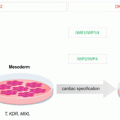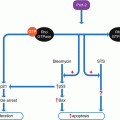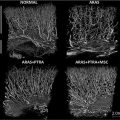M.A. Hayat (ed.)Stem Cells and Cancer Stem CellsStem Cells and Cancer Stem Cells, Volume 122014Therapeutic Applications in Disease and Injury10.1007/978-94-017-8032-2_2
© Springer Science+Business Media Dordrecht 2014
2. Emerging Concepts of Stem Cell Organization in the Normal Lung and in Lung Cancer
(1)
Lung Health Research Centre, Department of Pharmacology & Therapeutics, University of Melbourne, Level 8, Medical Building, Melbourne, VIC, 3010, Australia
Abstract
Gaps in our knowledge about the organization and regulation of regenerative cells in the normal and diseased adult lung have been a major impediment to the identification of targets around which improved therapies for intractable lung diseases and lung cancer could be developed. During the last decade, specific lung injury models, the availability of genetically engineered reporter mice, and the development of robust cell separative methods and clonogenic assays for the identification and characterization of adult lung epithelial stem cells have provided the field with powerful tools for the identification and validation of predictive stem cell biomarkers and critical molecular pathways and microenvironmental signals which regulate their behavior. These approaches are key to the development of new therapies to restore healthy lung epithelium following injury or disease.
Introduction
The respiratory epithelium forms a physical barrier to inhaled foreign particles and microbes, protecting the lung from infections. Epithelial maintenance in the steady-state, and epithelial regeneration and repair after damage, is thought to be mediated by the proliferation of continuously renewing endogenous stem cells and their differentiation into the specialized epithelial cells of the conducting airway and alveolar beds. However, progress in characterizing epithelial stem and progenitor cells in the adult lung and in identifying the critical microenvironmental signals which regulate their activity has been hampered by the lack of specific markers for their isolation and of robust functional assays to measure their potential. These limitations are being overcome with the increasing availability of instructive, genetically engineered reporter mouse models and the development and refinement of flow cytometric cell sorting strategies and in vitro clonogenic assays for their identification and quantitation. These approaches provide powerful tools for the analysis of the organization and regulation of regenerative cells in the healthy lung, and in advancing our knowledge of the dysregulated behavior of lung stem cells following injury, and in understanding the nature and properties of lung cancer initiating cells. In this chapter we discuss what is known about the identity and regulation of epithelial stem and progenitor cells in the developing and adult lung, and how this knowledge informs the characterization of lung cancer initiating cells and the development of novel therapies for lung diseases.
Lung Development
The analysis of fetal lung development has contributed significantly to our understanding of adult lung regeneration and repair after injury. The embryonic lung originates from epithelial progenitors located in the anterior foregut endoderm which form the bronchial airway tree by the process of branching morphogenesis. Briefly, following the outpouching of the foregut, epithelial lung buds grow into the surrounding mesenchyme where fibroblast growth factor-10 (Fgf-10) secreted by smooth muscle progenitors acts to promote epithelial progenitor cell proliferation and inhibit differentiation. As the airway branches, the descendants of these progenitors remain in the airway stalks where they begin to differentiate, while the progenitors continue to proliferate at the growing distal tips of the branching lung epithelium (Rawlins 2008). Cell lineage-tracing has confirmed that self-renewing epithelial progenitor cells give rise to all lung epithelial cell lineages during the pseudoglandular stage of lung development and are characterized by the expression of inhibitor-of-differentiation-2 (Id2) (Rawlins et al. 2009a). Tracheobronchial and bronchiolar airway lineages are subsequently established during the transition from the pseudoglandular to canalicular stage of lung development when proximal airway cells lose the ability to respond to mesenchymally-derived signals capable of inducing distal airway differentiation (Hong et al. 2004a).
Although the process of adult lung regeneration and repair is largely thought to recapitulate ontogeny (Warburton et al. 2001) current evidence suggests that separate epithelial progenitor cell populations are responsible for building the lung during fetal development, and for maintaining and replenishing epithelial cell lineages in the adult lung. This includes the observation that the majority of genes expressed in distal tip progenitor cells in the embryonic lung are not expressed in the adult lung (Rawlins 2008) and that Id2-positive progenitor cells which play a significant role in lung development are not retained in the adult lung (Rawlins et al. 2009a).
Heterogeneity of Adult Mouse Lung Epithelial Stem and Progenitor Cells
The composition of cells that comprise healthy adult lung epithelium varies along the proximal-distal axis of the lung. The tracheobronchial airways are lined by pseudostratified basal, non-ciliated club (previously named Clara cells) and ciliated cells, interspersed with neuroendocrine cells and collecting duct cells which extend into submucosal glands (SMG). The bronchiolar airways are lined by columnar epithelium largely comprising ciliated and club cells, as well as foci of neuroendocrine cells which are referred to as neuroepithelial bodies (NEB). Proximal airways and bronchiolar epithelia also contain interspersed mucus-producing goblet cells which increase markedly in abundance in chronic lung diseases such as asthma and chronic obstructive pulmonary disease (COPD). On the other hand, alveolar epithelium comprises alveolar type I (squamous) and type II (cuboidal) cells which are the primary sources of surfactant protein-C (SPC, Sftpc).
While it has long been accepted that damaged and senescent epithelial cells in the healthy lung are continually replenished by proliferating and differentiating stem and progenitor cells throughout life, it is only recently that significant inroads have been made into understanding the precise identity and organization of epithelial stem and progenitor cell pools responsible for epithelial homeostasis, regeneration and repair. This has been made possible by exploiting the selective toxicity of drugs to analyze the temporal pattern of epithelial cell regeneration following ablation of specific lung epithelial cell lineages; the development of genetically-engineered reporter mouse models for cell lineage tracing; and the development of robust flow cytometric cell separative strategies for the identification and prospective isolation of candidate lung stem and progenitor cells, and functional in vitro clonogenic assays to measure their incidence and proliferative and differentiative potential. The naphthalene-injury model has proven especially useful in describing the organization and properties of airway epithelial stem and progenitor cells. Mature club cells, which comprise the majority of the proximal airway epithelium, are selectively ablated by systemic administration of naphthalene because they express the CYP2F1 and CYP2F2 isoforms of cytochrome P450 enabling them to metabolize naphthalene to generate a cytotoxic derivative, while their precursors are spared (Buckpitt et al. 1992; Reynolds et al. 2000).
Temporal analysis of airway epithelial regeneration in naphthalene and hypoxic injury models has identified distinct progenitor cell populations in the submucosal glands (SMG) and proximal airways. In particular, experiments have identified that murine SMG duct cells that express Krt14 are resistant to severe hypoxic-ischemic injury (Hegab et al. 2011). This population was shown to be self-renewing and was capable of differentiation along ciliated and secretory lineages to SMGs tubules and ducts, as well as the epithelium overlying SMGs, suggesting that there is a multipotent progenitor cell responsible for maintaining the SMGs. In contrast, basal cells in the proximal airways act only as progenitors responsible for repopulation of airway epithelium (Hong et al. 2004b; Rawlins et al. 2009b). Lineage tracing using a cytokeratin-14 (Krt14)-CreER transgene to follow the fate of basal cells in the tracheobronchial airways of mice following naphthalene injury, showed that Krt14-positive basal cells were able to self-renew and labeled basal, ciliated and club cells (Hong et al. 2004a, b). Other studies have demonstrated that Krt5-labeled basal cells are also able to give rise to both ciliated and club cells in both the steady state and following injury (Rock et al. 2009). The relationship between Krt5 and Krt14-positive cells is unclear.
In the bronchiolar airways, epithelial stem/progenitor cells have been identified as naphthalene-resistant cells that also express club cell secretory protein (CCSP, Scgb1a1). These ‘variant club cells’ are located at the bronchioalveolar duct junction (BADJ) and are associated with calcitonin gene-related peptide (CGRP) expressing neuroepithelial bodies in the branching airways (Giangreco et al. 2002; Reynolds et al. 2000). Variant club cells are transit amplifying cells that give rise to mature club cells and ciliated cells following naphthalene-induced epithelial injury (Hong et al. 2004a, b). Another study has shown that progenitor cells at the BADJ express both airway (CCSP) and alveolar (SPC) epithelial lineage markers. Termed bronchioalveolar stem cells (BASCs), these cells are resistance to naphthalene-treatment and have been shown to proliferate in response to both bronchiolar and alveolar injury (Kim et al. 2005).
In the alveoli, it has long been established that alveolar type II (AT2) cells function as progenitor cells capable of giving rise to alveolar type I (AT1) cells. A recent study by Chapman and colleagues has shown that a subset of murine alveolar epithelial cells that express the integrin-receptor α6β4, but are deficient in pro-SPC, serve as alveolar progenitors during lung regeneration following bleomycin induced lung injury (Chapman et al. 2011). More recently, studies have also shown that despite being absent from the distal lung in the steady state, p63-expressing cells proliferate and contribute to alveolar regeneration in response to epithelial damage following H1N1 influenza infection (Kumar et al. 2011). The cell surface marker CD74, has also been identified as a positive-selection marker that enriches murine AT2 cells capable of generating alveolar-like colonies when cultured in Matrigel (Lee et al. 2012).
The diversity of epithelial progenitor cells identified in the adult lung in the various injury models suggests that the fate of epithelial stem and progenitor cells is context dependent. One study using an aggregation chimera mouse model showed that lung epithelium was maintained by randomly distributed progenitor cells during homeostasis and repair after moderate injury. In contrast stem cells associated with putative stem cell niches (BADJ and NEB) were necessary to regenerate the denuded lung epithelium after severe injury (Giangreco et al. 2009). Other studies using flow cytometry-based sorting strategies in combination with in vitro colony-forming assays (Bertoncello and McQualter 2011) have identified multipotent EpCAMpos Sca-1low α6pos β4pos CD24low epithelial stem/progenitor cell in the adult mouse lung (McQualter et al. 2010). When co-cultured with EpCAMneg Sca-1pos lung mesenchymal feeder cells in a Matrigel-based clonogenic assay, these cells form distinct airway, alveolar or mixed lineage epithelial colonies. Furthermore, when mixed-lineage colonies are dissociated and reseeded they are able to form lineage-restricted airway and alveolar colonies as well as reform mixed lineage colonies, while reseeding of airway and alveolar colonies gives rise to their respective lineages (McQualter et al. 2010). Separate studies have demonstrated that α6pos β4pos progenitor cells give rise to airway and alveolar epithelial cells (Chapman et al. 2011). These findings support the existence of an epithelial stem/progenitor cell hierarchy in the adult mouse lung, in which multipotent epithelial stem/progenitor cells are able to self renew and contribute descendants to airway and alveolar lineages.
Another recent study also reports that three different progenitor populations can be segregated from the heterogeneous EpCAMpos CD24low epithelial stem/progenitor cell population in mice on the basis of the differential expression of an Sftpc-GFP transgene (Chen et al. 2012). The different subsets were distributed along the proximal-distal lung axis, with GFP expression ranging from undetectable in the proximal conducting airways, to low in the terminal bronchioles and high in the alveoli. Furthermore, when placed into culture, GFPneg cells largely produced colonies that resembled pseudostratified epithelium, while GFPlow and GFPhi cells formed epithelial colonies that resembled distal airway epithelium. These findings support the concept that local hierarchies of epithelial progenitors are responsible for maintaining different epithelial regions along the proximal-distal lung axis.
Despite the recent advances in the identification of multipotent epithelial stem cells and lineage restricted progenitor cell populations in the adult lung, it remains an open question whether the adult lung epithelium is maintained by an epithelial stem/progenitor cell hierarchy with a single multipotent stem cell subpopulation that gives rise to regional lineage-specific progenitors or by discrete functionally distinct progenitor cells that maintain the anatomically diverse regions of the airways and alveoli.
Stay updated, free articles. Join our Telegram channel

Full access? Get Clinical Tree







